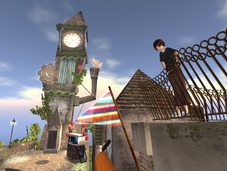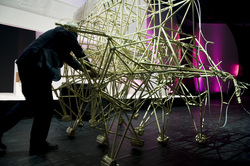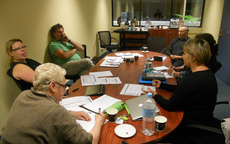
Photo courtesy of Stuart Miles, www.freedigitalphotos.net
 I am lucky to have friends and colleagues who will take the time to read my blogposts and comment on them. Such was the case with my last post about my tech support fears. I have had some feedback which made me blush with appreciation. I was told that I do not come across as someone with hesitations about technology; that I am the go-to person of choice for at least a few of my colleagues; and they've scolded me for thinking less of my abilities than they do. I should remember that how I see myself, and how others see me, is often different. In this case, I am fortunate--and humbled--to discover that others see me as tech-literate, a source of knowledge and help (and at the very least, supportive). So for all my trepidation at not always being able to keep up with the latest technological advances and trends, it's nice to receive a reassuring pat on the back for what I do know--and that I'm appreciated for it. :-)
Photo courtesy of Stuart Miles, www.freedigitalphotos.net
0 Comments
 I have a confession to make: I am afraid of being called upon to help with technology. This is after I've answered more than a few questions on Word tools, participated in a MOOC this summer to learn about digital footprints, published my master's portfolio in the required Livebinders format, and launched this professional webpage into cyberspace. I occasionally jump on Twitter--and even occasionally Tweet. For awhile, I was curating my Scoop.it page on digital citizenship and keeping up with my reading blog (which I will get back to, I promise!). I've attended online workshops, collect bookmarks on Delicious, and Facebook on a daily basis to keep up with worldwide friends, professional organizations, blogs, and the weather.
So why is it, with all this tech experience, do I quiver at the thought of being the "go-to" person for technology on my campus? Maybe it's because I've explored enough to realize that what I do know is just a fraction of what's out there and available to teachers and students. I know what works for me, what I can handle (constant Tweeting is not it, that's for sure), and what I consider "user-friendly"--but those are very personal descriptors, and everyone learns and works and organizes and thinks differently. Maybe I quiver because my tech experience is at the user-end of applications; please do not ask me how LANs or hard drives or doc cameras work. Just show me how to push the buttons, connect the hardware, store the data, take the pictures, and teach my students and staff what they need to know in an engaging, educational format. If you find a really cool online app, tell me how it fits into your classroom instruction and makes it better--I'll play with it, too! It's okay if I tear a little bit of hair out in the process; making mistakes is a part of learning. But time is a precious commodity to those of us who have less than 175 days a year to cover more than a year's worth of curriculum, to teach those phonics and reading strategies and math facts and problem solving skills and research paper requirements, while allowing for recess, read-alouds, counseling, lunch, and nose-blowing. It's a tall order for teachers and librarians alike. So please do not ever consider me a tech expert--I'm learning right along with you. I'll do my best to have a quiver-full of tech tools to lay before you, instead of quivering on the edge of the ocean of technology.  The photo I chose to illustrate this post shows how much our communication technology has changed in just the past two decades--and it doesn't even show the latest advances in smartphones. Changes in technology seem to happen every day, which is why I refuse to ever say that I'm an expert in anything technology-related; not only are there new versions and tools popping up constantly, there is seems to be more "bells and whistles" attached to each tool, and I'm fully aware that I don't know at least half of them! With all the hardware, software, and online applications available to schools, educators, and students in this digital age, it is a matter of finding what is easy, cost-efficient, and useful for the learning community.
What I do have going for me is that I am not a technophobe. I am ready, willing, and able to explore the possibilities for educational technology. I am a hands-on learner who needs to "mouse for myself" and play around with hardware and software before I feel comfortable using it with students and staff. I recognize that training takes time, and that is a precious commodity. I also realize this means a change in the role of teacher-librarian, but I am excited by the prospects. I want to have information available for my patrons in the form which suits them best, and for our digital natives, that means not only online access for the most current information, but also tools to create and produce their own materials for learning and assessment. I hope that the next two weeks of this module will provide me with more technological experience and knowledge that I can turn around and use in my classroom and future library position.  This week's topic is one I'm very familiar with--the role of thinking in the classroom. I work at an IB-PYP campus, and we are all about inquiry and HOTS--higher order thinking skills. I see the many times I ask my students "Why?" on a daily basis as payback for all the toddlers I've worked with in my career, including my own children. I enjoy watching my students' brains at work, seeing their squished up faces as they struggle to explain an answer, dig deeper for reasons, form an educated opinion. In many cases, students in my special education classroom are unused to being pressed to think, and they try to wait me out, to see if I'll pass over them and go on to the next student...but that doesn't usually happen in my room. In small group instruction, I have the advantage of wait time that my colleagues in larger settings often don't have--and so I press my students to think, to answer, to take risks. Some of them are just now, after twelve weeks, becoming comfortable to take that leap, but most will rise to the expectation by the end of the year.
As a librarian, I am looking forward to spurring inquiry in the minds of the learning community. I want to have books, displays, realia, bulletin boards, and a web presence that invites students and staff to explore the curriculum as well as their personal passions, and I want to help teachers do the same in their classrooms. I want to have quiet spaces for thinking in the library, and methods to show thinking that span multiple intelligences. I want to model my own "units of inquiry", things that I'm curious about and learning. I want to help create, as Dr. Ron Ritchhart has coined, a "culture of thinking" in my library and my school.  21st century learning has been a constant buzzword throughout the I DO Make a Difference modules. This is no coincidence, since it was the AASL who published Standards for the 21st-Century Learner (2007). One of the discussion questions asked for key words from the outline of Standards that stood out to us. This was my answer:
Reading is at the root of all learning, especially with the plethora of information available to us these days. Inquiry stands out; I'm seeing less curiosity towards learning in the students in my school, and I have to wonder why, especially since they have online access at school (which leads me then to think that we aren't letting them have access to it as much as we should!). If students lack curiosity and independent learning skills, then it is quite possible that as adults, they will not have the skills necessary to be fully engaged members of society, and will be easily misled and/or not live up to their full potential. I also like the idea that learning is social; if the learning environment promotes social learning, then it may be peer pressure that finally pushes apathetic students to become inquirers and learners themselves. I have to admit that my view is skewed toward elementary level learning; hence, the focus on reading, which is essential for learning at any level. The challenge that we have as educators in today's world is to engage our students in such a way that they want to learn the necessary basic skills, even while we are competing against all the entertainment that is available to them outside the school walls. Such entertainment is often rapid-fire and spoon-fed, and so we are also challenged to teach students to think, go deeper, and value intrinsic rewards more than extrinsic gratification. It is a daunting task, and we must use technology and social learning to our advantage in reaching our students and preparing them to be active, knowledgeable, fully participating citizens. This goes against our educational history of desks-in-a-row, pencil-and-paper, individual merit systems; it's time to take the leap and make the changes, to help our students make full use of their thinking skills and creativity in the workforce and beyond.  As teacher-librarians, we need to clarify our role in student learning for ourselves, before we can begin communicating it to our learning community and acting on it through our library programs. We need to know that we can, indeed, have a positive impact on students' academic achievement. While classroom teachers are responsible for curriculum content, we are responsible for teaching students how to find and evaluate information connected to that content and to their personal interests, and help them build upon that knowledge. We can model critical thinking skills using the resources of the program through direct instruction, collaboration, and the continuation of our own learning.
Inquiry is at the heart of 21st century learning, and what better place to start than in the library? By building a partnership with the administrative team as well as the teaching staff and learning community, the teacher-librarian is in a unique position to enhance the learning experiences of all patrons.  Libraries are becoming "learning commons"--not only repositories of print materials, realia, and computer banks, but also places where individual learning and collaboration occur in flexible spaces. This is in line with the needs of 21st century learners to become independent inquirers who are able to effectively find information, evaluate its usefulness, analyze how to use it, and work with others in sharing information and creating products to show their learning and communicate with others. Older library designs often inhibit these changes in learning, and building a facility to accommodate these needs requires planning and support.
Long-range planning for a library may start with a librarian's vision for the program, but it requires the buy-in and ongoing support of the entire learning community. The input of a library committee with representatives from all member groups--administration, teachers, students, and parents--is essential to this process. Parent groups such as the PTA can also be instrumental in supporting change and helping in funding. With a shared vision, research to support change, and an appropriate long-range plan, the teacher-librarian can meet the needs of 21st century learners in building a successful library space and programming.  As we listened to the Week 2 wrap-up of "I-DO Manage" this evening, the concept that kept popping up was change: the library changing to meet the needs of 21st century learners, changing the physical space to accommodate learning styles, changing displays to entice readers, and changing perceptions of our stakeholders through our interactions and our own continued learning efforts.
Ranganathan was prophetic when he wrote his fifth law of library science--"The library is a growing organism." The Five Laws of Library Science (Bombay: Asia Pub. House, 1963). Libraries have always been places of inquiry and learning; with the booming amount of information the digital age is affording us, the need for libraries to keep abreast of current resources and access to such information has grown exponentially. Finding, evaluating, using, and creating with this information requires a wide variety of materials, technology, and flexible spaces which sometimes clash with old facilities, old programs, and old ways of thinking about learning. None of these changes will be completely successful, however, without the interpersonal relationships that entice potential users of the library to avail themselves of the resources and services. As a librarian, I will have to convince my learning community that time spent in the library and with the materials is worthwhile. I will not only have to manage today's resources, physical space, and programming, but also look to the future and anticipate changes based on the needs of my patrons. This will require continuing education on my part, as well as advocacy efforts to bring about the needed changes. Hopefully, with relationships well-established, it will not be a solo mission--I'll have my learning community advocating right beside me.  This third module of the I-DO Make a Difference series focuses on the librarian as a manager--of facility, budget, resources, personnel, and program. We began by viewing a proposed lists of tasks a librarian undertakes, and were invited to amend it. Both the original list, and the items that the participants added, described an exhausting workload! I chose this image to represent what running a library entails: often just one lone librarian, dealing with so many details that have to be firmly rooted in curriculum, pedagogy, and campus needs and expectations but networked to cover all those needs and form a cohesive program. Whew!
The two concepts that arose to manage this diverse list of tasks were organization and creativity. A librarian should be, by nature, prone to organization--after all, our job is to organize resources and information in such a way as to make it easy for our patrons to efficiently find what they need. It's just that there is SO much to organize: the collection, the budget, the daily/weekly/yearly schedule, the learning spaces, and many other responsibilities that fall in a librarian's lap. And it all should be done in the spirit of customer service and curricular support. Another whew! Where organization requires great effort, I think creativity takes more thought: How am I going to draw in my patrons this week? What creative ways can I use to connect my library lesson to classroom learning, without sounding like a repeat of the lesson they just heard? What is going to surprise and delight and inform and entertain my community? Where an organizing project may end (such as yearly inventory), creativity must be drawn upon day after day, week after week, as needs and interests and student/staff populations change. Technology plays a huge role in this process as well--add keeping up with tech trends to the to-do list! Of all the modules in this series, this may be the one I learn the most from as a librarian wannabe. I have experience teaching and collaborating--but this will be the first time I manage a school-wide program. I'm looking forward to the next two weeks!  Emphasis was placed this week on the specifics of collaboration: group roles, logistics, administrative support, problem solving, and social marketing. While the last item may not seem to fit with those listed previously, it may be the most essential element to establishing a collaborative relationship between the librarian and the learning community. Can you see the woman in the picture to the left of her table, sticking her tongue out? Requests for collaborative meetings may be met with just that attitude, if the librarian has not established the social marketing process of AIDA: Attention, Interest, Desire, and Action.
So what does this mean for a brand new librarian like me? It means that when I am hired for a library position, I'm going to have to market myself and the library program. First, I'll have to gain the attention of my learning community through advertising. I'll have to get my staff, students, and parents interested in what the program has to offer by tuning in to their needs and those of the curriculum, making my skills and the services relevant, timely, and easy to access. Hopefully, this will lead to their desire to learn more about the services and utilize them. Desire will lead them to action--allowing me to collaborate with them, and eventually seeking out my skills and services without having to jump through the hoops of the AIDA process! I may have to take the lead in starting the collaborative process, but that doesn't necessarily mean I will be the leader in collaborative groups. Roles change and are as varied as the teams who come together and the purposes they serve. Ultimately, though, the goal of every collaborative effort on a school campus is student engagement and achievement. The two main hurdles to collaboration are time and administrative support. Using technology to support collaboration may help with time constraints. Convincing administrators to support my efforts to collaborate with the learning community may have me using that AIDA model yet again. Being confident in my skills, the library resources, and connecting with my "Why am I a librarian?" statement that we discussed in the I-DO Lead module will help guide me in fostering collaboration on my campus. |